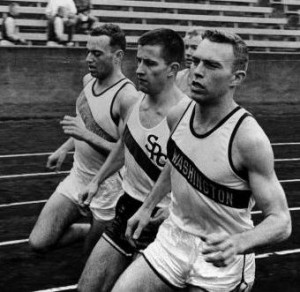A familiar voice said, “Today’s workout is 10 quarters at 62 [seconds]; jog a half lap [in between].”

Rounding the last bend of a mile race
So onto the black cinder track at the U of Washington, we went. Off on the first interval I ran smoothly straight at the first curve, just before got ready, and then felt the lurch to the left, leaning into the curve, and pushing a bit harder to stay up with the others. We glided through the curve, just before the back straightaway got ready, and then felt becoming relaxed, so to speak, to run smoothly straight toward the next and last curve.
Now that I think about last week’s post, ” When you run fast, your brain works harder,” I am still struck with the finding that when leg power in increased, so is hippocampal gamma oscillation power. So what is driving the hippocampus? Ahmed and Mehta surmise it is maybe visual and vestibulatory output. And what happens when you run or even walk around a curve?
Wagner and collaborators (2008) may have an answer. They used functional magnetic resonance to examine cerebral activation during mental imagery with the initiation of walking and maintenance of a curved path.
Some of their findings were: “Parahippocampal activation seen with right and left turns in our study was more pronounced than that seen with gait straight ahead. The (para-)hippocampal formation is known to be involved in navigation (…). This finding suggests that locomotion along a curved path requires more navigational cortical control than unrestricted locomotion straight ahead, which is largely based on automated motor patterns (…). Since parahippocampal activation has been associated with landmark retrieval (…) whereas the hippocampus has been reported to contain predominantly place-responsive cells, we cannot exclude that the parahippocampal activation seen in our subjects was due to greater requirement for spatial memory—rather than navigational requirements—in curved walking.” [(…) indicates that reference(s) were omitted]
These investigators wrote this summarization: “Parahippocampal …, known to be involved in visually guided navigation, showed more activity when walking along a curved path than when walking straight ahead.”
Thus, hippocampal oscillatory power could well be used to maneuver us around turns. Also Singh et al. (2011) reported that during the gait cycle, there was a modulation of basal ganglia oscillations in patients with dystonia. Indeed, Petersen et al. (2012) showed, and Raethjen & Muthuraman (2012) agreed, that synchrony exists between cortical signals and muscle electrical activity and is an important aspect of gait function.
Is it possible that impairment of these oscillations and the synchrony between cortical, subcortical, spinal, and muscle electrical activities is critical during maintenance of gait in endurance events? Maybe this impairment is more than associated with having to increase effort to keep on race pace?
After a break, I will return to address these questions. Enjoy the holidays! Phil
References:
Petersen TH, Willerslev-Olsen M, Conway BA, Nielsen JB (2012). The motor cortex drives the muscles during walking in human subjects. J Physiol 590:2443-2452.
Raethjen J, Muthuraman, M (2012). Corticomuscular coupling in human locomotion: muscle drive or gait control? J Physiol 590:3631-3632.
Singh A, Kammermeier S, Mehrkens JH, Ilmberger J, Bötzel K (2011). Pattern of local field potential activity in globus pallidus internum of dystonic patients during walking on a treadmill. Exp Physiol 232:162-167.
Wagner J, Stephan T, Kalla R, Brückmann H, Strupp M, Brandt, T, Jahn K (2008). Mind the Bend: cerebral activations associated with mental imagery of walking along a curved path. Exp Brain Res 191:247-255.